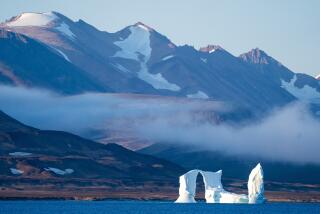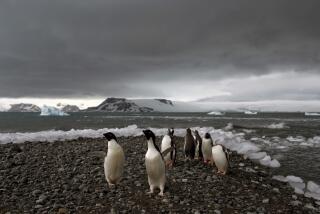Study casts doubt on rate of Antarctic sea ice growth
- Share via
A new study suggests that scientists must reexamine records that show increases in Antarctic sea ice since 1979. Researchers found that something changed in the way satellite data get converted into ice cover, but they can’t yet identify the exact nature of the change, or whether it fixed a problem or introduced one.
They can say that their results show either Antarctic sea ice has not expanded as much as previously reported or it has been gaining ground for longer than scientists realized. The study was published this week in the journal The Cryosphere.
The paradox of expanding Antarctic sea ice has troubled scientists for many years. Although climate models predict southern sea ice should shrink, it has stubbornly refused to do so. In fact, between the last two reports of the Intergovernmental Panel on Climate Change (IPCC), which came out just seven years apart, the rate of Antarctic sea ice growth more than doubled.
The prevailing explanation held that extending the relatively short sea ice record by a few more years had simply revealed an accelerating trend.
“It’s really noisy,” said lead author of the new study, Ian Eisenman of UC San Diego’s Scripps Institution of Oceanography. “Adding more data could change it. It’s not that surprising.”
But when Eisenman dug into the individual papers that informed the IPCC reports, he saw that a jump in growth rates took place in just one year, between studies that came out in 2006 and 2007.
In fact, a change had occurred: scientists at NASA’s Goddard Space Flight Center, who process the raw data, had tweaked the procedure they used to convert satellite measurements into ice cover. Specifically, they issued an update to a computer algorithm known as Bootstrap and with it, reprocessed the entire 35-year sea ice record.
Eisenman and his colleagues show in the new study that this changed sea ice trends overnight. When they analyzed the same sea ice data with both versions of Bootstrap, they got different results, which means one has to be wrong, Eisenman said.
The problem seems to arise from how Bootstrap handled a change in satellite sensors that took place in 1991. But he emphasized that they haven’t identified what part of the update was responsible for the change.
“At the end of the day, whatever we find is the root, I doubt it’s anything egregious,” Eisenman said. “Instead, it’s something probably quite subtle and nuanced.”
He also says they don’t know which dataset is right: the one based on the old Bootstrap or the new one.
“You’d think you could tell which one it was,” Eisenman said, “but there’s so much month-to-month variability, you can’t.”
Instead, he concludes, the problem could lie with either one.
“The paper raises two possibilities and doesn’t discern between them,” Eisenman said. “It is begging for a second step, it only tells half the story.” He plans to continue looking into it, and after this paper, others probably will too.
Some people have already come out in support of the new version of the sea ice record, which shows Antarctic sea ice expanding at a faster rate. These include Josefino Comiso, who oversees NASA’s satellite sea ice data and personally made the Bootstrap update. He told Nature News that he trusts the more recent estimates, which agree with other estimates of sea ice growth. (Eisenman said it’s not quite that simple.)
But while the study marks “an excellent piece of scientific vigilance,” as Paul Holland of the British Antarctic Survey told Nature, it doesn’t change the overall story of Antarctic sea ice.
“Both datasets say Antarctic sea ice is expanding now at a statistically significant rate,” Eisenman said. At best, it might make the trend a little easier to explain.
“If the error is in the current version, it doesn’t resolve the problem, but it does lessen it,” Eisenman said. “But if the error is in the old dataset, it will not help us resolve that enigma.”
Ted Scambos, a sea ice expert at the National Snow and Ice Data Center, agrees: “I don’t think this lets us off the hook of explaining how Antarctica’s sea ice is expanding in a warming world,” he told Nature.
For all things science, follow me @ScienceJulia







